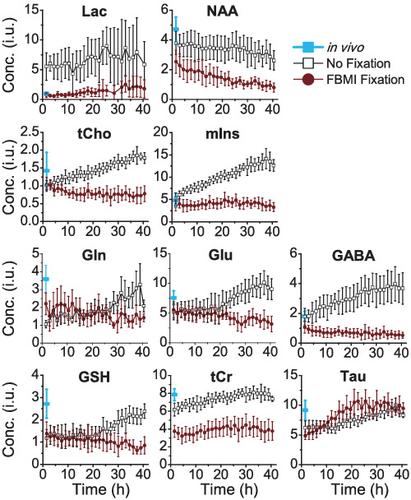当前位置:
X-MOL 学术
›
NMR Biomed.
›
论文详情
Our official English website, www.x-mol.net, welcomes your feedback! (Note: you will need to create a separate account there.)
Comparison of in vivo and in situ detection of hippocampal metabolites in mouse brain using 1H‐MRS
NMR in Biomedicine ( IF 2.9 ) Pub Date : 2020-11-30 , DOI: 10.1002/nbm.4451 Chao‐Hsiung Hsu, Stephen Lin, Ai‐Chen Ho, T. Derek Johnson, Paul C. Wang, Joseph Scafidi, Tsang‐Wei Tu
NMR in Biomedicine ( IF 2.9 ) Pub Date : 2020-11-30 , DOI: 10.1002/nbm.4451 Chao‐Hsiung Hsu, Stephen Lin, Ai‐Chen Ho, T. Derek Johnson, Paul C. Wang, Joseph Scafidi, Tsang‐Wei Tu

|
The study of cerebral metabolites relies heavily on detection methods and sample preparation. Animal experiments in vivo require anesthetic agents that can alter brain metabolism, whereas ex vivo experiments demand appropriate fixation methods to preserve the tissue from rapid postmortem degradation. In this study, the metabolic profiles of mouse hippocampi using proton magnetic resonance spectroscopy (1H‐MRS) were compared in vivo and in situ with or without focused beam microwave irradiation (FBMI) fixation. Ten major brain metabolites, including lactate (Lac), N‐acetylaspartate (NAA), total choline (tCho), myo‐inositol (mIns), glutamine (Gln), glutamate (Glu), aminobutyric acid (GABA), glutathione (GSH), total creatine (tCr) and taurine (Tau), were analyzed using LCModel. After FBMI fixation, the concentrations of Lac, tCho and mIns were comparable with those obtained in vivo under isoflurane, whereas other metabolites were significantly lower. Except for a decrease in NAA and an increase in Tau, all the other metabolites remained stable over 41 hours in FBMI‐fixed brains. Without FBMI, the concentrations of mIns (before 2 hours), tCho and GABA were close to those measured in vivo. However, higher Lac (P < .01) and lower NAA, Gln, Glu, GSH, tCr and Tau were observed (P < .01). NAA, Gln, Glu, GSH, tCr and Tau exhibited good temporal stability for at least 20 hours in the unfixed brain, whereas a linear increase of tCho, mIns and GABA was observed. Possible mechanisms of postmortem degradation are discussed. Our results indicate that a proper fixation method is required for in situ detection depending on the targeted metabolites of specific interests in the brain.
中文翻译:

使用 1H-MRS 对小鼠脑中海马代谢物的体内和原位检测的比较
脑代谢物的研究在很大程度上依赖于检测方法和样品制备。体内动物实验需要可以改变大脑代谢的麻醉剂,而离体实验需要适当的固定方法来保护组织免于死后快速降解。在本研究中,使用质子磁共振波谱分析小鼠海马的代谢特征 ( 1H-MRS)在体内和原位进行了比较,有或没有聚焦束微波辐射(FBMI)固定。10 种主要脑代谢产物,包括乳酸 (Lac)、N-乙酰天冬氨酸 (NAA)、总胆碱 (tCho)、肌醇 (mIns)、谷氨酰胺 (Gln)、谷氨酸 (Glu)、氨基丁酸 (GABA)、谷胱甘肽 (GSH) )、总肌酸 (tCr) 和牛磺酸 (Tau) 使用 LCModel 进行分析。FBMI 固定后,Lac、tCho 和 mIns 的浓度与在异氟醚下体内获得的浓度相当,而其他代谢物则明显较低。除了 NAA 减少和 Tau 增加外,所有其他代谢物在 FBMI 固定的大脑中在 41 小时内保持稳定。在没有 FBMI 的情况下,mIns(2 小时前)、tCho 和 GABA 的浓度与体内测量值接近。然而,较高的 Lac ( P< .01) 并且观察到较低的 NAA、Gln、Glu、GSH、tCr 和 Tau ( P < .01)。NAA、Gln、Glu、GSH、tCr 和 Tau 在未固定大脑中表现出至少 20 小时的良好时间稳定性,而观察到 tCho、mIns 和 GABA 线性增加。讨论了死后降解的可能机制。我们的结果表明,根据大脑中特定兴趣的目标代谢物,原位检测需要适当的固定方法。
更新日期:2021-01-04
中文翻译:

使用 1H-MRS 对小鼠脑中海马代谢物的体内和原位检测的比较
脑代谢物的研究在很大程度上依赖于检测方法和样品制备。体内动物实验需要可以改变大脑代谢的麻醉剂,而离体实验需要适当的固定方法来保护组织免于死后快速降解。在本研究中,使用质子磁共振波谱分析小鼠海马的代谢特征 ( 1H-MRS)在体内和原位进行了比较,有或没有聚焦束微波辐射(FBMI)固定。10 种主要脑代谢产物,包括乳酸 (Lac)、N-乙酰天冬氨酸 (NAA)、总胆碱 (tCho)、肌醇 (mIns)、谷氨酰胺 (Gln)、谷氨酸 (Glu)、氨基丁酸 (GABA)、谷胱甘肽 (GSH) )、总肌酸 (tCr) 和牛磺酸 (Tau) 使用 LCModel 进行分析。FBMI 固定后,Lac、tCho 和 mIns 的浓度与在异氟醚下体内获得的浓度相当,而其他代谢物则明显较低。除了 NAA 减少和 Tau 增加外,所有其他代谢物在 FBMI 固定的大脑中在 41 小时内保持稳定。在没有 FBMI 的情况下,mIns(2 小时前)、tCho 和 GABA 的浓度与体内测量值接近。然而,较高的 Lac ( P< .01) 并且观察到较低的 NAA、Gln、Glu、GSH、tCr 和 Tau ( P < .01)。NAA、Gln、Glu、GSH、tCr 和 Tau 在未固定大脑中表现出至少 20 小时的良好时间稳定性,而观察到 tCho、mIns 和 GABA 线性增加。讨论了死后降解的可能机制。我们的结果表明,根据大脑中特定兴趣的目标代谢物,原位检测需要适当的固定方法。



























 京公网安备 11010802027423号
京公网安备 11010802027423号